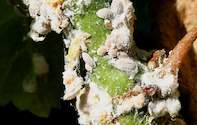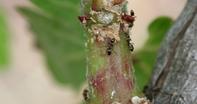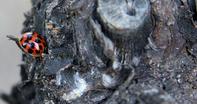These two pests are discussed together since ants and grapevine mealybugs are usually related and may indicate the presence of the other.

Grapevine mealybugs can also be transmitted by ants and the appearance of ants can indicate a possible mealybug infection since the honeydew they secrete is the primary food source of ants.
The grapevine mealybug female secretes waxy threads which form the ovisac. In the larval stage, the larvae move from the leaf to the grape bunches. Black sooty mould grows on the honeydew that is secreted by the mealybug and the black discolouration can be seen on the infected vines. Grapevine mealybugs also spread grapevine leafroll disease.

The main purpose of control must, therefore, be to prevent grapevine mealybugs from infecting the grape clusters or spreading to the other grapevines, but the management of ants is the first step in mealybug control. Plastic placed over the berm (soil strip directly below the vine row) can in some cases provide the ideal environment for the nesting of ants.
If large numbers of active-moving ants are observed under the plastic, it should be removed as soon as possible. High-growing weeds can provide alternate pathways for ants to enter the vines and should be avoided especially during the growing season.
Using a cover crop system can help control weeds, while also having other beneficial effects on natural enemies of the grapevine mealybug.
The natural enemies of mealybugs are especially the larvae of ladybirds (feeds on the mealybug) and their wasps that attack the adult females. Monitoring of grapevine mealybugs includes the use of pheromone traps to catch the males.

Infested vines are marked during the growing season so that they can be treated with a suitable chemical agent during the winter, before budding.
It is important that the adjacent vines are also treated. Thorough wetting of the vines is essential because mealybugs hide during the winter under the dead bark and on the roots. In cases of severe mealybug infections, a soil-administered systemic insecticide can be used.
Place sticky insect barriers or barriers treated with a chemical pesticide around the trunk and trellising wires for the control of ants.
By Marinda Louw